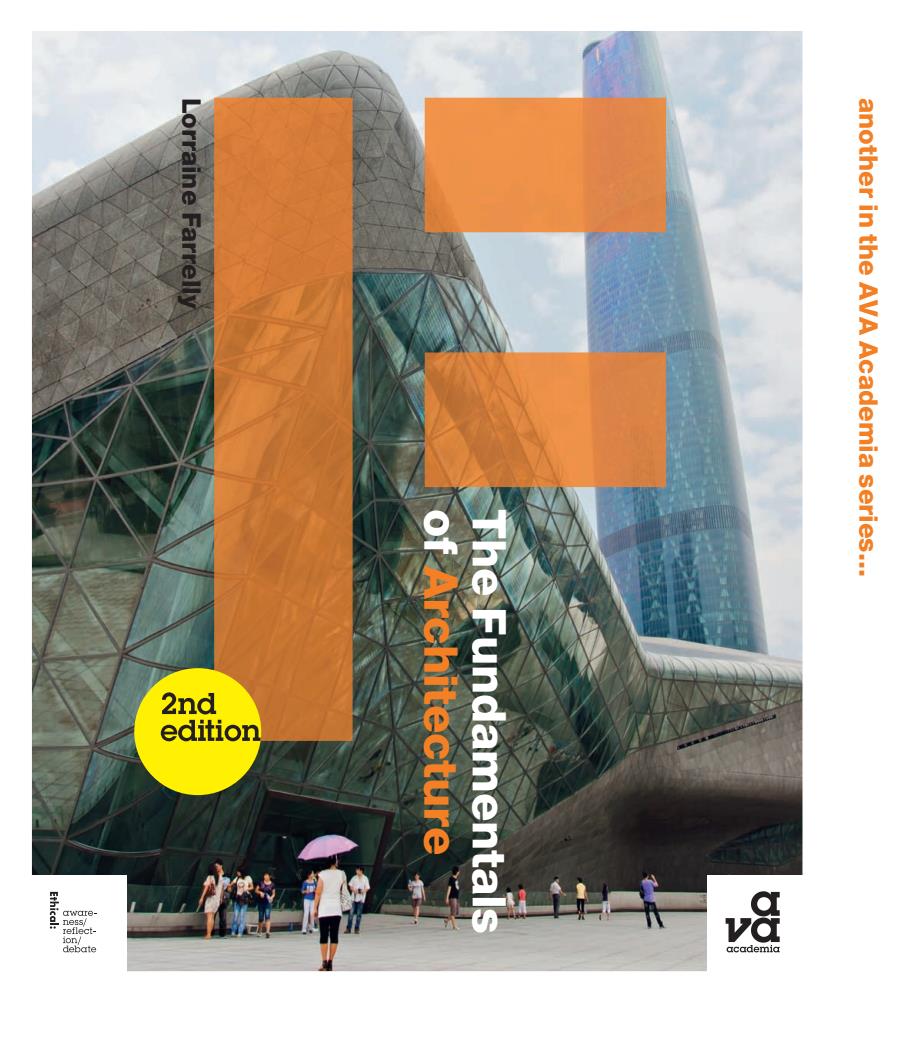
Lorraine Farrelly another in the AVA Academia series... 2nd edition of Architecture The Fundamentals Ethical: aware- ness/ reflect- va ion/ debate academig
of The Fundamentals Architecture Lorraine Farrelly another in the AVA Academia series... ava publishing sa www.avabooks.com http://blog.avabooks.com enquiries@avabooks.com sales@avabooks.com Lorraine Farrelly is an architect and Professor of Architecture and Design at the Portsmouth School of Architecture, UK. She teaches design studio at undergraduate and postgraduate in architecture. In addition, she teaches courses in representation and drawing. Her studio teaching focuses on the idea of the city and how it is read and interpreted. Her previous books include Representational Techniques (2007) and Construction and Materiality (2008). Lorraine Farrelly The Fundamentals of Architecture Ethical practice is well known, taught and discussed in the domains of medicine, law, science and sociology but was, until recently, rarely discussed in terms of the Applied Visual Arts. Yet design is becoming an increasingly integral part of our everyday lives and its influence on our society ever-more prevalent. AVA Publishing believes that our world needs integrity; that the ramifications of our actions upon others should be for the greatest happiness and benefit of the greatest number. We do not set ourselves out as arbiters of what is ‘good’ or ‘bad’, but aim to promote discussion in an organized fashion for an individual’s understanding of their own ethical inclination. By incorporating a ‘working with ethics’ section and cover stamp on all our titles, AVA Publishing aims to help a new generation of students, educators and practitioners find a methodology for structuring their thoughts and reflections in this vital area. Publisher’s note AVA’s Fundamentals titles are designed to introduce students to the key elements of visual arts subjects and the ideas that underpin them. Packed with examples from students and professionals, and fully illustrated with clear diagrams and inspiring imagery, they offer an essential introduction to the applied visual arts. The Fundamentals of Architecture is a practical, accessible introduction to the concepts and processes of modern architecture. Throughout this book, Lorraine Farrelly unravels the key areas of investigation and study associated with architectural thinking, design and implementation. This revised and updated second edition includes detailed case studies and practical projects to help you explore the process of architecture, and incorporate best practice techniques into your own work. It will also guide you through the rich history of architecture around the world and introduce you to essential elements of contemporary theory and practice. Praise for the first edition of The Fundamentals of Architecture ‘This book is awesome. Wonderfully designed, easy to understand, great images, great writing. What a wonderful overview of so many aspects of the design and practice of architecture.’ Eric Stark, Assistant Professor of Architecture, University of Maine at Augusta, USA ‘An attractive introduction to the world of architecture and what is required of an architect... very good for those at school considering a career choice in architecture. It is also a good general overview of thinking across the whole field of architecture. The graphic design is attractive and the images well chosen.’ John Napier RIBA, Senior Lecturer in Architecture, University of Lincoln, UK £26.50 US$38.50 ISBN: 978-2-940411-75-7 9 782940 411757 Job no: CD0412-49 / Sammi 4th proof AVA : Fund Architecture 2nd Edition Cover-23FebGK_.indd 1 4/27/12 2:07 PM
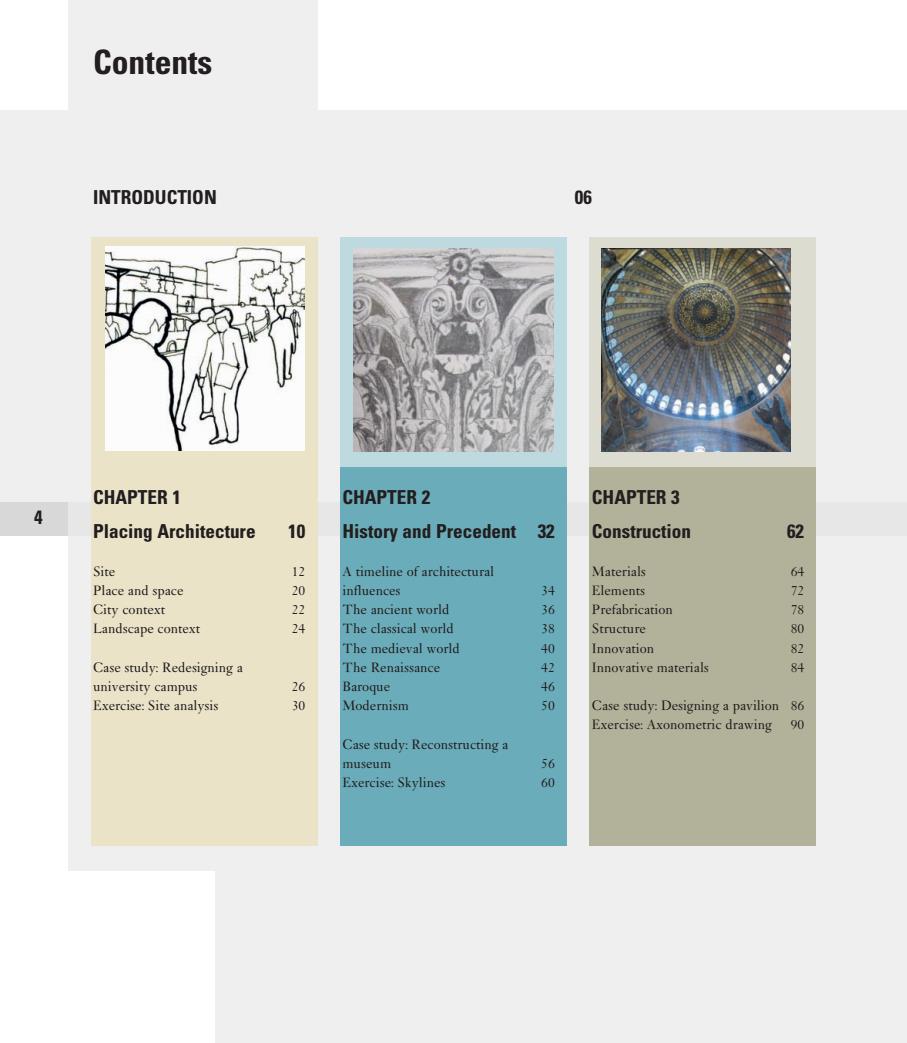
Contents INTRODUCTION 06 CHAPTER 1 CHAPTER 2 CHAPTER 3 4 Placing Architecture 10 History and Precedent 32 Construction 62 Site 12 A timeline of architectural Materials 64 Place and space 20 influences 34 Elements 7 City context The ancient world 36 Prefabrication Landscape context 24 The classical world 38 Structure 80 The medieval world Innovation 82 Case study:Redesigning a The Renaissance 42 Innovative materials 84 university campus 26 Baroque 46 Exercise:Site analysis 30 Modernism 50 Case study:Designing a pavilion 86 Exercise:Axonometric drawing 90 Case study:Reconstructing a museum 56 Exercise:Skylines 60
Job No: D0312-18 / YEE PEI 1st Proof Title: Fund Architecture 2nd Edition (AVA) 76451_CTP_001-045GK_2Mar_.indd 4 Text 3/13/12 4:59 PM Black Contents INTRODUCTION 06 CHAPTER 3 Construction 62 Materials 64 Elements 72 Prefabrication 78 Structure 80 Innovation 82 Innovative materials 84 Case study: Designing a pavilion 86 Exercise: Axonometric drawing 90 CHAPTER 2 History and Precedent 32 A timeline of architectural influences 34 The ancient world 36 The classical world 38 The medieval world 40 The Renaissance 42 Baroque 46 Modernism 50 Case study: Reconstructing a museum 56 Exercise: Skylines 60 CHAPTER 1 Placing Architecture 10 Site 12 Place and space 20 City context 22 Landscape context 24 Case study: Redesigning a university campus 26 Exercise: Site analysis 30 4 Job No: D0312-18 / YEE PEI 1st Proof Title: Fund Architecture 2nd Edition (AVA) 76451_CTP_001-045GK_2Mar_.indd 4 3/13/12 4:59 PM
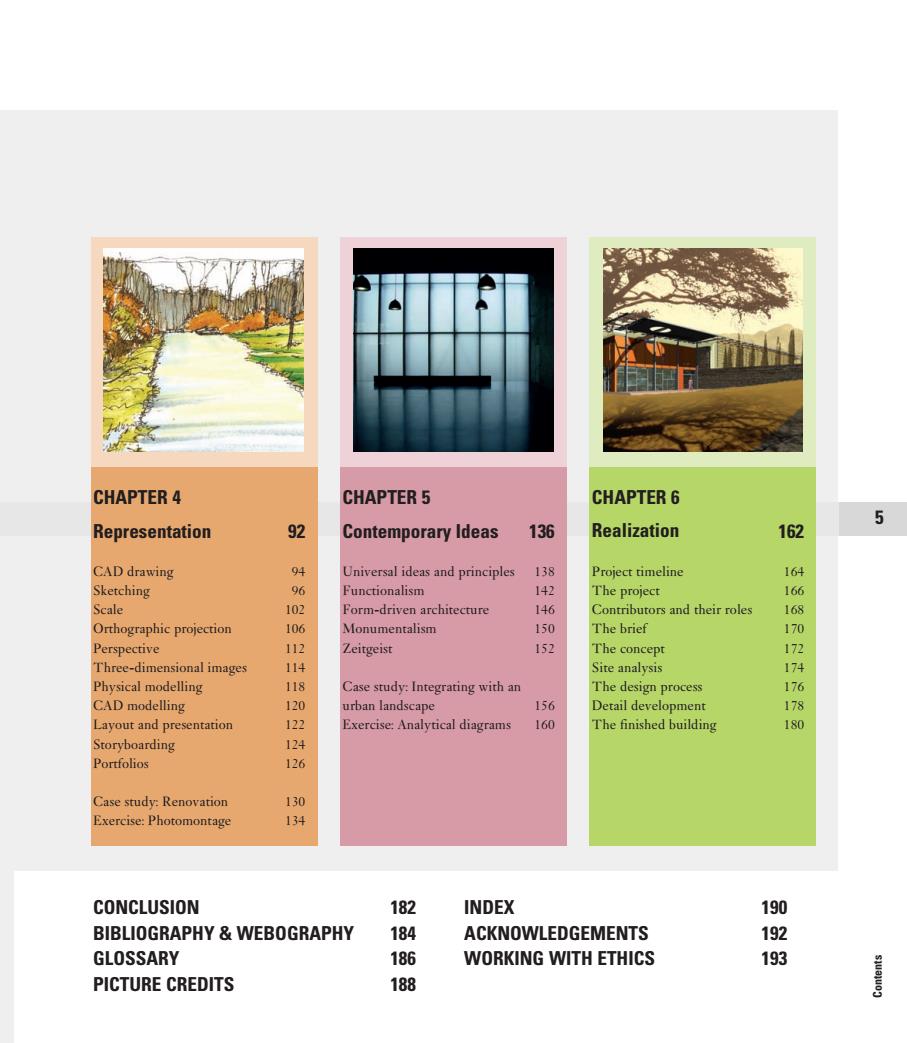
CHAPTER 4 CHAPTER 5 CHAPTER 6 5 Representation 92 Contemporary Ideas 136 Realization 162 CAD drawing 94 Universal ideas and principles 138 Project timeline 164 Sketching 96 Functionalism 142 The project 166 Scale 102 Form-driven architecture 146 Contributors and their roles 168 Orthographic projection 106 Monumentalism 150 The brief 170 Perspective 112 Zeitgeist 152 The concept 172 Three-dimensional images 114 Site analysis 174 Physical modelling 118 Case study:Integrating with an The design process 176 CAD modelling 120 urban landscape 156 Detail development 178 Layout and presentation 122 Exercise:Analytical diagrams 160 The finished building 180 Storyboarding 124 Portfolios 126 Case study:Renovation 130 Exercise:Photomontage 134 CONCLUSION 182 INDEX 190 BIBLIOGRAPHY WEBOGRAPHY 184 ACKNOWLEDGEMENTS 192 GLOSSARY 186 WORKING WITH ETHICS 193 PICTURE CREDITS 188
Job No: D0312-18 / YEE PEI 1st Proof Title: Fund Architecture 2nd Edition (AVA) 76451_CTP_001-045GK_2Mar_.indd 5 Text 3/13/12 4:45 PM Black CONCLUSION 182 BIBLIOGRAPHY & WEBOGRAPHY 184 GLOSSARY 186 PICTURE CREDITS 188 INDEX 190 ACKNOWLEDGEMENTS 192 WORKING WITH ETHICS 193 CHAPTER 6 Realization 162 Project timeline 164 The project 166 Contributors and their roles 168 The brief 170 The concept 172 Site analysis 174 The design process 176 Detail development 178 The finished building 180 CHAPTER 5 Contemporary Ideas 136 Universal ideas and principles 138 Functionalism 142 Form-driven architecture 146 Monumentalism 150 Zeitgeist 152 Case study: Integrating with an urban landscape 156 Exercise: Analytical diagrams 160 CHAPTER 4 Representation 92 CAD drawing 94 Sketching 96 Scale 102 Orthographic projection 106 Perspective 112 Three-dimensional images 114 Physical modelling 118 CAD modelling 120 Layout and presentation 122 Storyboarding 124 Portfolios 126 Case study: Renovation 130 Exercise: Photomontage 134 Contents 5 Job No: D0312-18 / YEE PEI 1st Proof Title: Fund Architecture 2nd Edition (AVA) 76451_CTP_001-045GK_2Mar_.indd 5 3/13/12 4:46 PM
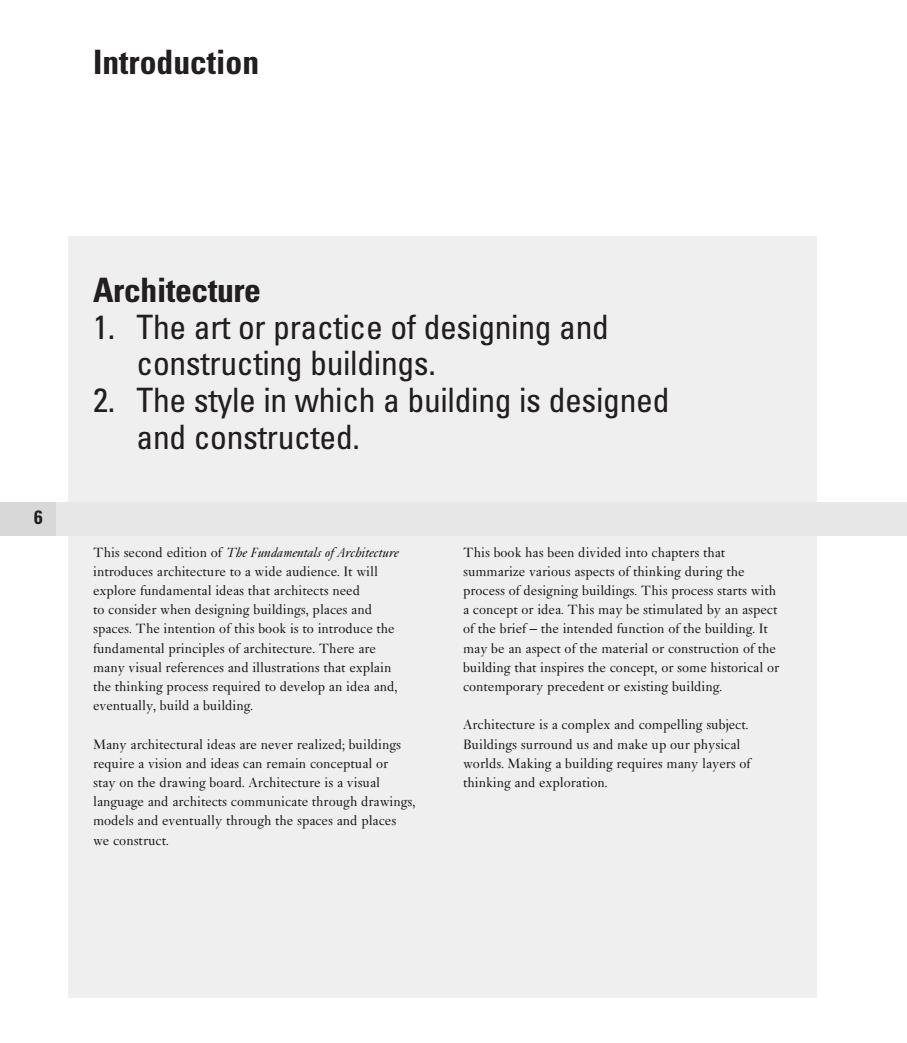
Introduction Architecture 1.The art or practice of designing and constructing buildings. 2.The style in which a building is designed and constructed. 6 This second edition of Tbe Fundamentals of Arcbitecture This book has been divided into chapters that introduces architecture to a wide audience.It will summarize various aspects of thinking during the explore fundamental ideas that architects need process of designing buildings.This process starts with to consider when designing buildings,places and a concept or idea.This may be stimulated by an aspect spaces.The intention of this book is to introduce the of the brief-the intended function of the building.It fundamental principles of architecture.There are may be an aspect of the material or construction of the many visual references and illustrations that explain building that inspires the concept,or some historical or the thinking process required to develop an idea and, contemporary precedent or existing building. eventually,build a building. Architecture is a complex and compelling subject. Many architectural ideas are never realized;buildings Buildings surround us and make up our physical require a vision and ideas can remain conceptual or worlds.Making a building requires many layers of stay on the drawing board.Architecture is a visual thinking and exploration. language and architects communicate through drawings, models and eventually through the spaces and places we construct
Job No: CD0412-49 / Sammi 2nd Proof Title: Fund Architecture 2nd Edition (AVA) 76451_CTP_001-045GK_2Mar_.indd 6 Text 4/27/12 12:42 PM Black Introduction Architecture 1. The art or practice of designing and constructing buildings. 2. The style in which a building is designed and constructed. This second edition of The Fundamentals of Architecture introduces architecture to a wide audience. It will explore fundamental ideas that architects need to consider when designing buildings, places and spaces. The intention of this book is to introduce the fundamental principles of architecture. There are many visual references and illustrations that explain the thinking process required to develop an idea and, eventually, build a building. Many architectural ideas are never realized; buildings require a vision and ideas can remain conceptual or stay on the drawing board. Architecture is a visual language and architects communicate through drawings, models and eventually through the spaces and places we construct. This book has been divided into chapters that summarize various aspects of thinking during the process of designing buildings. This process starts with a concept or idea. This may be stimulated by an aspect of the brief – the intended function of the building. It may be an aspect of the material or construction of the building that inspires the concept, or some historical or contemporary precedent or existing building. Architecture is a complex and compelling subject. Buildings surround us and make up our physical worlds. Making a building requires many layers of thinking and exploration. 6 Job No: CD0412-49 / Sammi 2nd Proof Title: Fund Architecture 2nd Edition (AVA) 76451_CTP_001-045GK_2Mar_.indd 6 4/27/12 12:42 PM
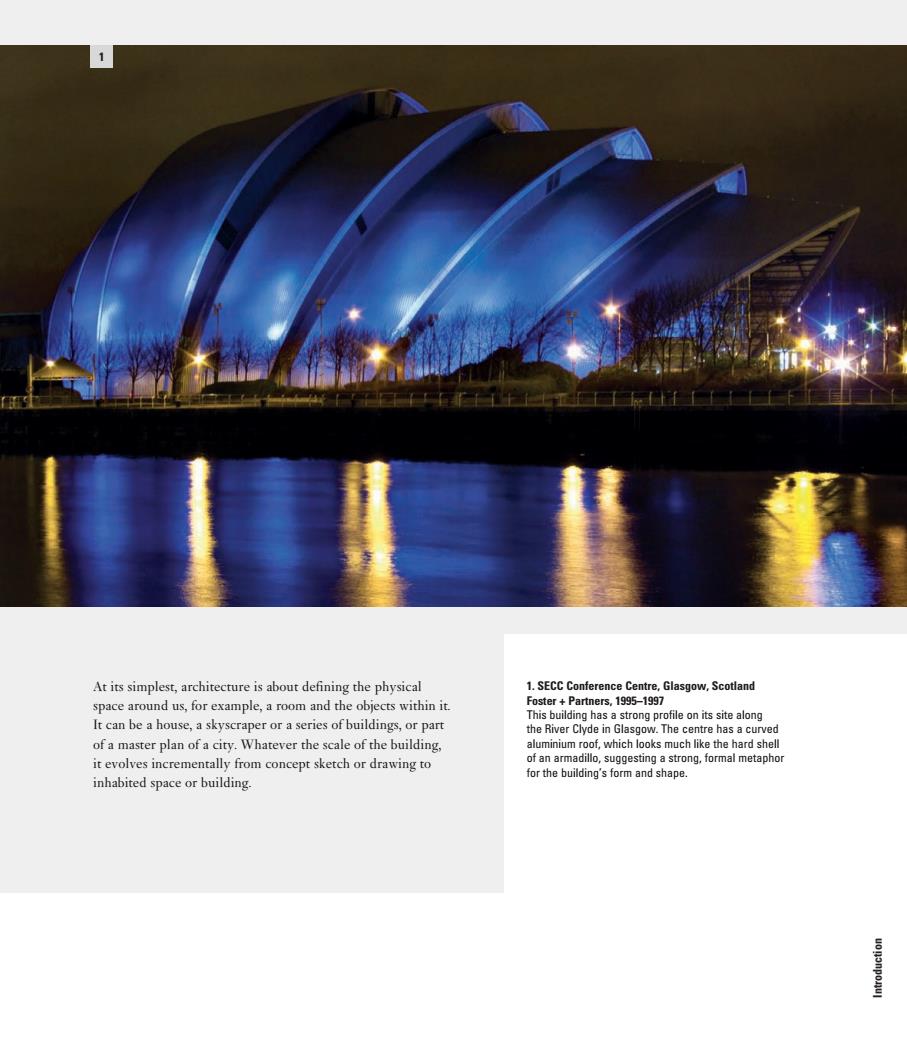
At its simplest,architecture is about defining the physical 1.SECC Conference Centre,Glasgow,Scotland space around us,for example,a room and the objects within it. Foster+Partners,1995-1997 This building has a strong profile on its site along It can be a house,a skyscraper or a series of buildings,or part the River Clyde in Glasgow.The centre has a curved of a master plan of a city.Whatever the scale of the building, aluminium roof,which looks much like the hard shell it evolves incrementally from concept sketch or drawing to of an armadillo,suggesting a strong,formal metaphor for the building's form and shape. inhabited space or building
Job No: CD0412-3 / Sammi 2nd Proof Title: Fund Architecture 2nd Edition (AVA) 76451_CTP_001-045GK_2Mar_.indd 7 Text 4/4/12 5:52 PM Black 1 1. SECC Conference Centre, Glasgow, Scotland Foster + Partners, 1995–1997 This building has a strong profile on its site along the River Clyde in Glasgow. The centre has a curved aluminium roof, which looks much like the hard shell of an armadillo, suggesting a strong, formal metaphor for the building’s form and shape. At its simplest, architecture is about defining the physical space around us, for example, a room and the objects within it. It can be a house, a skyscraper or a series of buildings, or part of a master plan of a city. Whatever the scale of the building, it evolves incrementally from concept sketch or drawing to inhabited space or building. Introduction Job No: CD0412-3 / Sammi 2nd Proof Title: Fund Architecture 2nd Edition (AVA) 76451_CTP_001-045GK_2Mar_.indd 7 4/4/12 5:52 PM